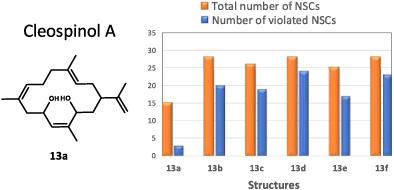当前位置:
X-MOL 学术
›
Magn. Reson. Chem.
›
论文详情
Our official English website, www.x-mol.net, welcomes your
feedback! (Note: you will need to create a separate account there.)
Enhancing Computer Assisted Structure Elucidation with DFT analysis of J -couplings
Magnetic Resonance in Chemistry ( IF 1.9 ) Pub Date : 2020-02-24 , DOI: 10.1002/mrc.4996 Alexei V Buevich 1 , Mikhail E Elyashberg 2
Magnetic Resonance in Chemistry ( IF 1.9 ) Pub Date : 2020-02-24 , DOI: 10.1002/mrc.4996 Alexei V Buevich 1 , Mikhail E Elyashberg 2
Affiliation

|
Computer‐assisted structure elucidation (CASE) is the class of expert systems that derives molecular structures primarily from one‐dimensional and two‐dimensional nuclear magnetic resonance data. Contemporary CASE systems, including Advanced Chemistry Development/Structure Elucidator (ACD/SE), consider cross‐peaks in heteronuclear multiple bond coherence (HMBC) and correlation spectroscopy (COSY) spectra as two‐ or three‐bond correlations by default. However, four and more bond correlations (nonstandard correlations [NSCs]) could be present in these spectra too. The indiscriminate addition of NSCs to the CASE computations is prohibitively expensive. To address this problem, the ACD/SE program performs a logical analysis of observed correlations and determines the minimum number of NSCs. Guided by this information, a more efficient fuzzy structure generation (FSG) algorithm is subsequently applied. Until now, the FSG algorithm was utilized without any verification of the reliability of found NSCs. Here, we report a verification method for NSCs based on the relationship between NSCs and J‐couplings computed with high accuracy density functional theory (DFT) methods. We used the example of strychnine to show that 41 (32%) of 8‐Hz HMBC cross‐peaks were NSCs and were consistent with 4–6JCH couplings greater than 0.3 Hz. This cutoff value was largely confirmed by the analysis of NSCs in 11 real‐world natural products elucidated by ACD/SE. Additionally, utilizing the example of the CASE study of cleospinol A, we showed that the DFT‐computed J‐couplings of NSCs can distinctively differentiate the correct structure among six proposed isomers. The proposed approach of NSC verification should further improve the robustness of CASE analysis and can help reveal potential problems with reported experimental data.
中文翻译:

通过 J 型耦合的 DFT 分析增强计算机辅助结构解析
计算机辅助结构解析 (CASE) 是一类主要从一维和二维核磁共振数据推导出分子结构的专家系统。现代 CASE 系统,包括 Advanced Chemistry Development/Structure Elucidator (ACD/SE),默认情况下将异核多键相干 (HMBC) 和相关光谱 (COSY) 光谱中的交叉峰视为双键或三键相关。然而,在这些光谱中也可能存在四个或更多的键相关性(非标准相关性 [NSC])。在 CASE 计算中不加选择地添加 NSC 是非常昂贵的。为了解决这个问题,ACD/SE 程序对观察到的相关性进行逻辑分析并确定 NSC 的最小数量。在这些信息的指导下,随后应用了更有效的模糊结构生成 (FSG) 算法。到目前为止,FSG 算法的使用没有对所发现的 NSC 的可靠性进行任何验证。在这里,我们报告了一种基于 NSC 与使用高精度密度泛函理论 (DFT) 方法计算的 J 耦合之间关系的 NSC 验证方法。我们以士的宁为例表明 41 (32%) 个 8-Hz HMBC 交叉峰是 NSC,并且与大于 0.3 Hz 的 4-6JCH 耦合一致。该临界值在很大程度上通过 ACD/SE 阐明的 11 种真实世界天然产物中的 NSC 分析得到证实。此外,利用 cleospinol A 的 CASE 研究的例子,我们表明 DFT 计算的 NSC 的 J 偶联可以在六种提议的异构体中区分正确的结构。
更新日期:2020-02-24
中文翻译:

通过 J 型耦合的 DFT 分析增强计算机辅助结构解析
计算机辅助结构解析 (CASE) 是一类主要从一维和二维核磁共振数据推导出分子结构的专家系统。现代 CASE 系统,包括 Advanced Chemistry Development/Structure Elucidator (ACD/SE),默认情况下将异核多键相干 (HMBC) 和相关光谱 (COSY) 光谱中的交叉峰视为双键或三键相关。然而,在这些光谱中也可能存在四个或更多的键相关性(非标准相关性 [NSC])。在 CASE 计算中不加选择地添加 NSC 是非常昂贵的。为了解决这个问题,ACD/SE 程序对观察到的相关性进行逻辑分析并确定 NSC 的最小数量。在这些信息的指导下,随后应用了更有效的模糊结构生成 (FSG) 算法。到目前为止,FSG 算法的使用没有对所发现的 NSC 的可靠性进行任何验证。在这里,我们报告了一种基于 NSC 与使用高精度密度泛函理论 (DFT) 方法计算的 J 耦合之间关系的 NSC 验证方法。我们以士的宁为例表明 41 (32%) 个 8-Hz HMBC 交叉峰是 NSC,并且与大于 0.3 Hz 的 4-6JCH 耦合一致。该临界值在很大程度上通过 ACD/SE 阐明的 11 种真实世界天然产物中的 NSC 分析得到证实。此外,利用 cleospinol A 的 CASE 研究的例子,我们表明 DFT 计算的 NSC 的 J 偶联可以在六种提议的异构体中区分正确的结构。











































 京公网安备 11010802027423号
京公网安备 11010802027423号